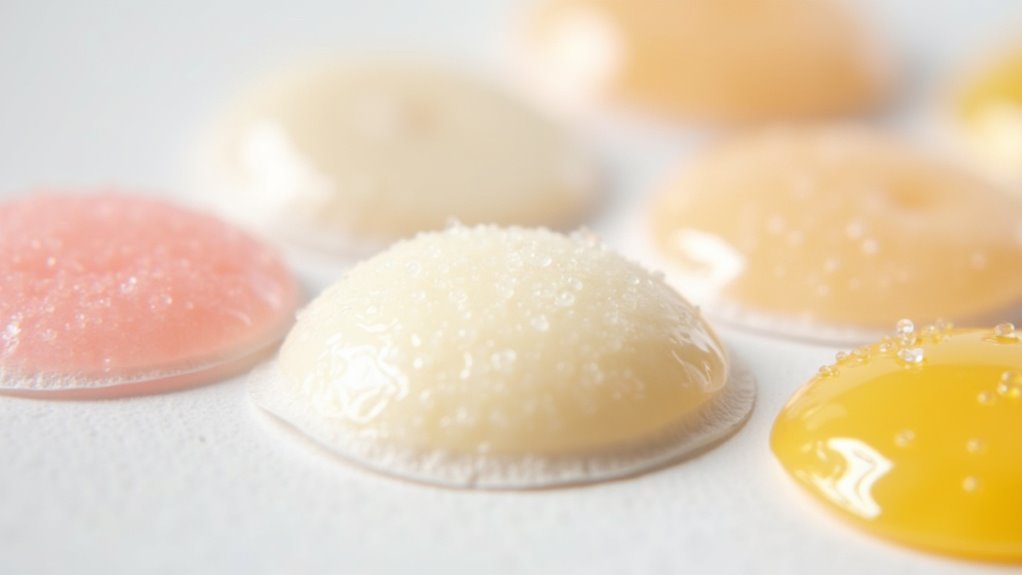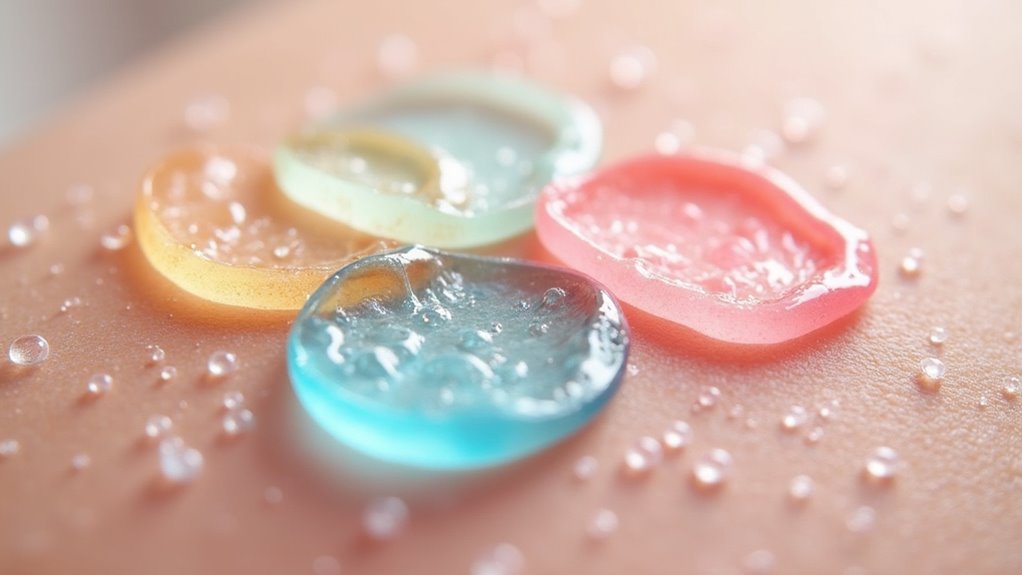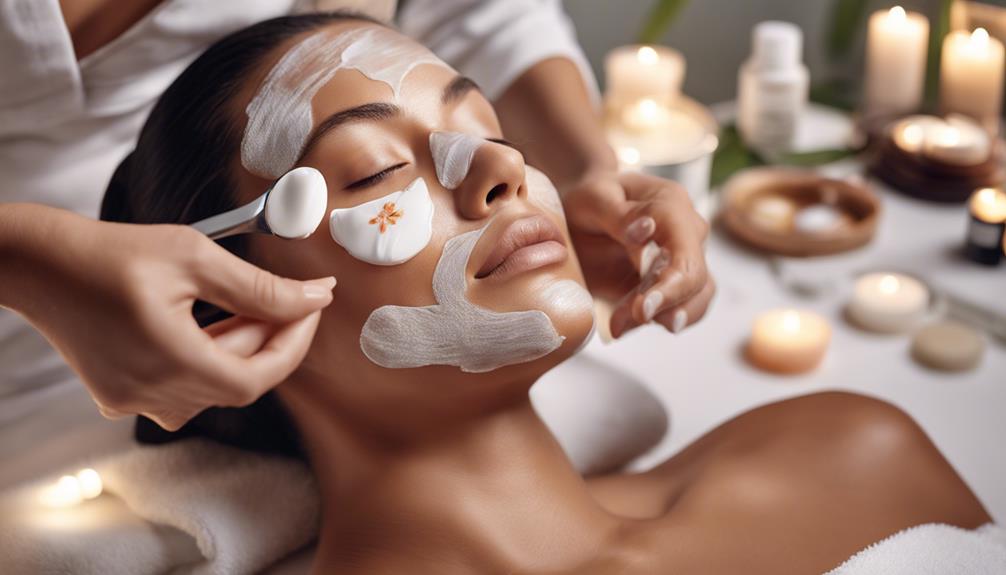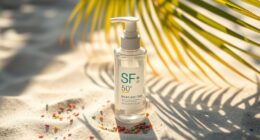The white gunk on your pimple patch is actually hydrated hydrocolloid dressing. It means the patch is effectively soaking up moisture, pus, and impurities from your blemish. This change in color indicates that it’s doing its job, helping to heal while protecting against bacteria. Remember, it’s essential to apply your patch on whiteheads for best results. Keep going, and you’ll discover more tips for maximizing the effectiveness of your pimple patches.
Key Takeaways
- The white gunk on pimple patches is hydrated hydrocolloid dressing, indicating successful moisture absorption from the blemish.
- This change in color shows that the patch is drawing out excess fluids like pus and sebum.
- The patch creates a moist environment that promotes healing and reduces inflammation around the pimple.
- If the patch turns completely white, it indicates saturation and should be replaced after 8 hours.
- The white residue helps maintain a clean surface on the blemish, aiding in effective healing.
How Do Pimple Patches Work?

When you apply a pimple patch, it works by using hydrocolloid dressing to absorb excess fluids like pus and sebum from your blemish.
These pimple patches create a protective barrier, shielding your acne from bacteria and external irritants. As the hydrocolloid absorbs the excess fluid, it forms a moist environment that promotes healing and reduces inflammation.
You may notice the patch turning white, which indicates it’s saturated and has successfully done its job. Some patches even contain active ingredients like salicylic acid to further enhance their effectiveness against acne.
What Is the White Stuff on Pimple Patches?

Pimple patches are designed to absorb the fluids from your blemishes, and the white stuff you see on them isn’t pus or skin debris. This white residue is actually hydrated hydrocolloid dressing that absorbs moisture and oil from your pimple. When the patch turns white, it indicates that it’s effectively drawing out impurities, aiding in the healing process and reducing inflammation. Here’s a quick overview of what happens:
| White Stuff | Function | Result |
|---|---|---|
| Hydrated | Absorbs excess fluids | Reduces inflammation |
| Hydrocolloid | Promotes healing | Speeds up recovery |
| Moisture | Indicates patch effectiveness | Leads to clearer skin |
| Pimple | Targets blemish | Helps maintain a clean and dry surface |
| Patch | Protects the area | Prevents further irritation |
Understanding this helps clarify misconceptions about blemish patches.
Dos and Don’ts for Effective Pimple Patch Use

After understanding the white residue on pimple patches, it’s important to know how to use them effectively. Follow these dos and don’ts for ideal results:
Understanding the white residue on pimple patches is key to using them effectively for clearer skin.
- Do clean and dry your skin before applying patches to guarantee maximum adhesion and absorption of fluid from blemishes.
- Don’t leave patches on longer than 8 hours; if they turn white, replace them, as this means they’ve absorbed their maximum capacity.
- Do apply patches to whiteheads for the best results, as they’re specifically designed to absorb fluid from pimples with visible heads.
Avoid applying skincare products directly on top of the patch, as moisture can hinder effectiveness.
Stick to these tips for effective pimple patch use and clearer skin!
Hydrocolloid Bandages vs. Pimple Patches

While both hydrocolloid bandages and pimple patches utilize similar technology to absorb fluids, they serve distinct purposes in skincare.
Hydrocolloid patches are primarily designed for wound care, while acne patches target individual blemishes to promote healing. These pimple patches often contain active ingredients like salicylic acid, enhancing their effectiveness against acne.
In contrast, hydrocolloid bandages lack these targeted additives. Pimple patches are thinner and discreet, making them ideal for facial use, whereas hydrocolloid bandages are thicker and cater to various wound types.
When using pimple patches, if the patch turns white, it indicates fluid absorption. Regular maintenance of air purifier filters can also help maintain a healthy environment, which is beneficial for skin health.
Always consider your skin types and conduct a patch test to verify compatibility with external irritants before applying any product.
Tips for Choosing the Right Pimple Patch

Selecting the right pimple patch can greatly impact your skincare routine, especially after understanding the differences between hydrocolloid bandages and targeted acne patches.
Choosing the appropriate pimple patch can significantly enhance your skincare regimen by understanding the distinctions between hydrocolloid bandages and targeted acne patches.
Here are some tips for choosing the right pimple patch:
- Know your skin type: Oily skin may benefit from patches with salicylic acid, while dry or sensitive skin should opt for soothing ingredients like hyaluronic acid.
- Consider transparency and coverage: Transparent patches work better under makeup, while thicker patches provide more coverage and protection overnight.
- Check the ingredients list: Verify there are no irritants or allergens that could worsen your breakouts.
Frequently Asked Questions
What Is the White Gunk on Pimple Patches?
The white gunk on pimple patches is actually a hydrated hydrocolloid that’s absorbed fluids from your blemish.
When you place the patch on, it pulls out pus and sebum, indicating it’s working effectively.
This white substance isn’t pus or skin debris; it’s just the patch becoming saturated.
Seeing this residue means the patch is helping to reduce inflammation and promote healing, giving you a visual cue of its effectiveness.
Why Does My Pimple Patch Keep Turning White?
If your pimple patch keeps turning white, it’s a sign that it’s doing its job. The patch is absorbing pus and excess oil from your blemish, indicating successful fluid absorption.
This color change happens as the hydrocolloid material hydrates. However, if it turns white too quickly, it might be due to exposure to air or products.
In any case, once it’s white, it’s time to replace it with a fresh patch for continued effectiveness.
How Do Pimple Patches Draw Out Pus?
Pimple patches draw out pus by using hydrocolloid technology, which creates a moist environment that absorbs excess fluids from your blemish.
When you apply the patch, it sticks to your skin and forms a barrier, preventing bacteria from entering.
As it absorbs the pus and sebum, the patch swells and changes color, indicating it’s working.
This process helps reduce the size and inflammation of your pimple, promoting faster healing.
Do Pimple Patches Cause Discoloration?
No, pimple patches don’t cause discoloration on your skin.
Instead, they absorb impurities and fluids, which may lead to a change in the patch’s appearance. When you place a patch on a blemish, it can turn white as it soaks up pus and sebum, indicating it’s working.
Just make sure your skin is clean and dry before applying to minimize any potential skin reactions, ensuring best results.
Conclusion
So, next time you use a pimple patch and notice that white gunk, remember—it’s just the patch doing its job, pulling out impurities and healing your skin. It’s funny how a little adhesive can turn a frustrating blemish into a moment of self-care. You might even find yourself smiling at the sight, realizing that sometimes, the messiest moments lead to the clearest skin. Embrace the journey, and let those patches work their magic!
Claire has a knack for turning complex dermatological concepts into engaging, easy-to-understand articles. Her work primarily focuses on creating detailed reviews and thought-provoking articles in the “Vetted” category. Claire’s writing not only informs but also inspires our community to try new skincare solutions.










